
The Malabar Coast moist forests are a tropical moist broadleaf forest ecoregion of southwestern India.

The South Deccan Plateau dry deciduous forests is a tropical dry forest ecoregion in southern India. The ecoregion lies in the southernmost portion of the Deccan Plateau, and includes the southernmost portion of the Eastern Ghats.

Terminalia is a genus of large trees of the flowering plant family Combretaceae, comprising nearly 300 species distributed in tropical regions of the world. The genus name derives from the Latin word terminus, referring to the fact that the leaves appear at the very tips of the shoots.
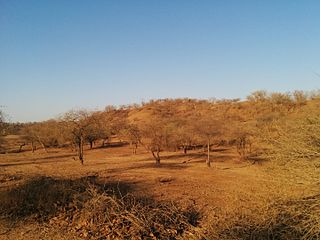
The Khathiar–Gir dry deciduous forests is a mostly arid ecoregion in northwestern India that stretches over 103,100 sq mi (267,000 km2) across Gujarat, Rajasthan and Madhya Pradesh. The dry deciduous forests in the region are dominated by teak, and thorny trees and scrub in drier areas.

Senegalia senegal is a small thorny deciduous tree from the genus Senegalia, which is known by several common names, including gum acacia, gum arabic tree, Sudan gum and Sudan gum arabic. In parts of India, it is known as Kher or Khor. It is native to semi-desert regions of Sub-Saharan Africa, as well as Oman, Pakistan, and west coastal India. It grows to a height of 5–12 metres (16-40'), with a trunk up to 30 cm (1') in diameter. Sudan is the source of the world's highest quality gum arabic, known locally as hashab gum in contrast to the related, but inferior, gum arabic from Red acacia or talah gum.

Fraxinus latifolia, the Oregon ash, is a member of the ash genus Fraxinus, native to western North America.
The Bori Wildlife Sanctuary is a wildlife sanctuary in Hoshangabad District of Madhya Pradesh state in central India.

Vachellia nilotica, more commonly known as Acacia nilotica, and by the vernacular names of gum arabic tree, babul, thorn mimosa, Egyptian acacia or thorny acacia, is a flowering tree in the family Fabaceae. It is native to Africa, the Middle East and the Indian subcontinent. It is also considered a 'weed of national significance' and an invasive species of concern in Australia, as well as a noxious weed by the federal government of the United States.
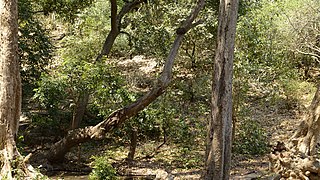
The Central Deccan Plateau dry deciduous forests in Western and Southern India, containing large protected areas of natural tiger habitat.

Senegalia catechu, previously known as Acacia catechu, is a deciduous, thorny tree which grows up to 15 m (50 ft) in height. The plant is called kachu in Malay; the Malay name was Latinized to "catechu" in Linnaean taxonomy, as the species from which the extracts cutch and catechu are derived. Other common names for it include kher, catechu, cachou, cutchtree, black cutch, and black catechu.

Vachellia karroo, commonly known as the sweet thorn, common acacia, Karoo thorn, Cape gum or cockspur thorn, is a species of Vachellia, in the Mimosa sub-family (Mimosoideae) of the Fabaceae or pea family, which is native to southern Africa from southern Angola east to Mozambique, and south to South Africa.

Madhuca longifolia is an Indian tropical tree found largely in the central, southern, north Indian plains and forests, Nepal, Myanmar and Sri Lanka. It is commonly known as madhūka, madkam, mahuwa, Butter Tree, mahua, mahwa, mohulo, Iluppai, Mee or Ippa-chettu. It is a fast-growing tree that grows to approximately 20 meters in height, possesses evergreen or semi-evergreen foliage, and belongs to the family Sapotaceae. It is adaptable to arid environments, being a prominent tree in tropical mixed deciduous forests in India in the states of Odisha, Chhattisgarh, Jharkhand, Uttar Pradesh, Bihar, Maharashtra, Andhra Pradesh, Madhya Pradesh, Kerala, Gujarat, West Bengal and Tamil Nadu.
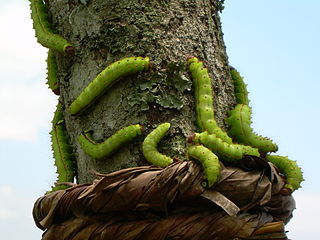
Wild silks have been known and used in many countries from early times, although the scale of production is far smaller than that from cultivated silkworms. Silk cocoons and nests often resemble paper or cloth, and their use has arisen independently in many societies.
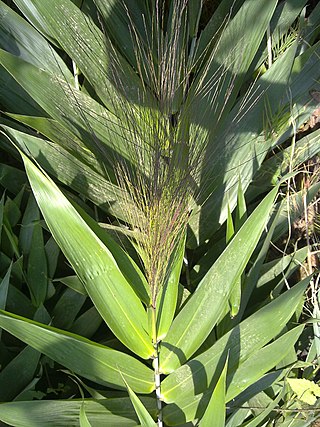
Thysanolaena is a monotypic genus of the grass family, in the tribe Thysanolaeneae. Its only recognized species is Thysanolaena latifolia, native to Bangladesh, Bhutan, Cambodia, China, India, Indonesia, Laos, Malaysia, Myanmar, Nepal, New Guinea, Philippines, Sri Lanka, Taiwan, Thailand, and Vietnam. It is also naturalized in Mauritius, Seychelles, Gambia, Tanzania, Hawaii, California, the West Indies and Brazil. Tiger grass, Nepalese broom grass, broom grass, broom stick are common names for this plant, in Nepali amliso and jharu in Assamese. The flowers of this plant are used as cleaning tool or broom, which is known askuchcho in Nepali and jhadu in Hindi.
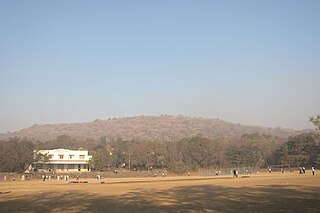
Vetal Hill is a prominent hill in the city limits of Pune, India. The hill is the highest point within the city limits, with an elevation of 800 meters (2,600 ft). The temple of Vetala is located on the top of the hill from which the hill derives its name. The Indian Forest Department maintains an observation deck near the temple. The hill is also known by its Marathi name, Vetal Tekdi.
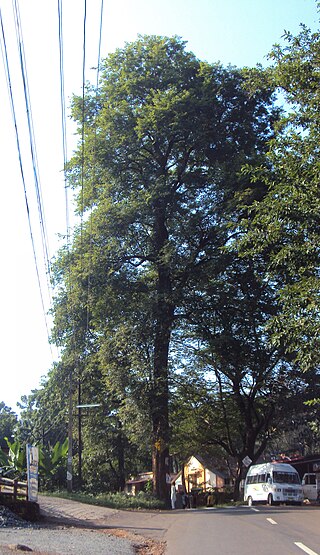
Dalbergia latifolia is a premier timber species, also known as the Indian rosewood. It is native to low-elevation tropical monsoon forests of south east India. Some common names in English include rosewood, Bombay blackwood, roseta rosewood, East Indian rosewood, reddish-brown rosewood, Indian palisandre, and Java palisandre. Its Indian common names are beete, and satisal or sitsal. The tree grows to 40 metres (130 ft) in height and is evergreen, but locally deciduous in drier subpopulations.

Antheraea paphia, known as the South India small tussore, the tasar silkworm and vanya silkworm is a species of moth of the family Saturniidae found in India and Sri Lanka. The bulk of the literature on this species uses a junior synonym, Antheraea mylitta, rather than the correct name, A. paphia. It is one of a number of tasar silkworms, species that produce Tussar silk, a kind of wild silk that is made from the products of saturniid silkworms instead of the domesticated silkworm.
Alchornea latifolia is a species of tree in the family Euphorbiaceae. It is native to Central and South America, as well as the Caribbean, where its common names include aguacatillo, baconá and chote.
Karanja Sohol Wildlife Sanctuary is a protected area in the Karanja talukas of Washim district in Maharashtra, India. It was created in 2000 to preserve the black buck population. It covers 1,832 ha (18.32 km2) of forest and grasslands.
Telangana has special climatic conditions due to its unique location in the heart of the Deccan Plateau. It is considered suitable for the developing flora and fauna. There are famous wildlife sanctuaries all over the region.The state of Telangana harbors a total of 2,800 taxa belonging to 1,051 genera under 185 families with its diverse ecosystems and varied agro-climatic regions, is home to a rich and vibrant flora. The state's flora encompasses a wide range of plant species, including both native and cultivated varieties.Telangana tropical rainy type of climate prevails, The State has a wide variety of soils and they form into three broad categories - red, black and laterite with Tropical moist deciduous forests, Southern dry deciduous forests, Northern mixed dry deciduous forests.


















